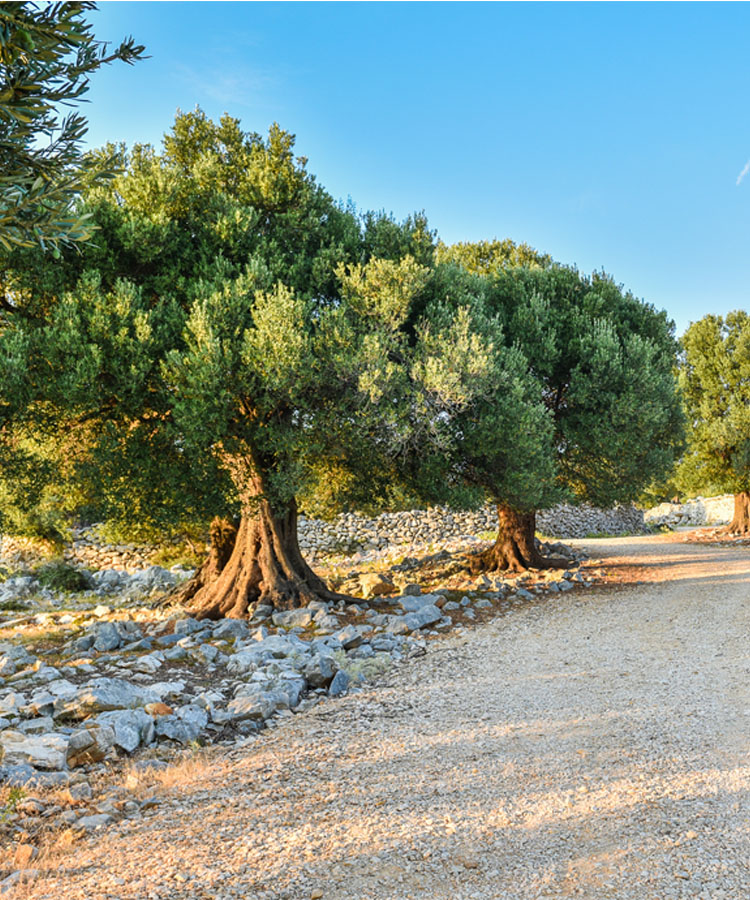Excellent olive oil has a lot in common with great wine. Both are complex, pair beautifully with food, and have been produced for centuries. That’s not referring to the large-format, blended bottles lining grocery store shelves; those are the Carlo Rossis of oil.
In some circumstances, wine and olive oil share something else: a home base. Some of the top wineries in the world also produce excellent olive oil. In fact, in famous winemaking regions like Tuscany, vineyards and olive groves are often interspersed throughout the countryside.
Nicholas Coleman is an oleologist, or olive oil expert, and co-founder of a bespoke olive oil subscription service named Grove and Vine. According to Coleman, olives for oil production thrive in moderate to warm climates, with hot, dry days and cool nights, benefiting from day-night temperature swings in the same way that wine grapes do. They both also benefit from rockier, less- fertile soils; grapevines and olive trees become stronger by struggling to reach for nutrients and water absorbed underground.
The link is also cultural. Both wine and olive oil are considered essential parts of the Mediterranean diet. Most winery-produced olive oils (or olive oil maker-produced wines) come from classic Mediterranean regions, such as central and southern Italy, southern France, Spain, Portugal, and Greece, or wine regions with Mediterranean climates, such as Napa and Sonoma.
And, as in winemaking, olive oil producers have a choice of whether to prioritize commercialization and quantity over artisanal production and quality. The best often choose the latter.
“It’s crucial to plant the right olive cultivar or grape varietal in the correct microclimate so they live in symbiotic relationship with nature,” Coleman says. “The best producers work with their momentum without trying to redirect it.” Therefore, it’s necessary to harvest olive oil (which has only one harvest per year, like wine) at the right time, rather than the easiest or most profitable time. It’s also important to select olive varieties that work best with their regions, rather than the ones that are highest-yielding. Top wineries understand these philosophies.
There are many winery-produced olive oils out there, but a few combine excellent materials and practices to produce top-notch iterations. Here are five of our favorites.
Valentini
This iconic Italian winemaker produces layered Trebbiano and Montepulciano wines, some of which are thought to be among the “unicorns” of Abruzzo. The Valentini estate also includes olive groves, and all of Abruzzo’s best restaurants have Valentini olive oil on the tables. But while Valentini’s olive oil may not be as expensive as its wines, it might be just as rare for U.S. wine drinkers to get their hands on, so booking a ticket to Abruzzo might be the best way to taste it.
Esporão
Esporão is one of the largest producers of dry Portuguese wine, with estates in both the southern Alentejo and northern Douro regions of Portugal. In addition to its wide range of wines, Esporão is also known for its series of olive oils. Most are produced at the winery’s Alentejo estate, Herdade do Esporão, but there are some Douro olive oils as well. Because Esporão produces single-variety and single-appellation olive oils, largely from indigenous Portuguese olives, this winery’s olive oils are an excellent opportunity to explore the differences from bottling to bottling.
Castello di Albola
The picturesque Castello di Albola winery sits within the hills of Chianti near the town of Radda, surrounded by both vineyards and olive groves. This estate sits at a higher elevation than others in Chianti, giving the wines both freshness and acidity and the olives ideal ripening potential. Castello di Albola’s olive oil is made from the Frantoio, Moraiolo, and Leccino varieties, giving a rounder, fruitier style of oil.
Domaine de Marquiliani
Located on the eastern coast of Corsica in a village called Aghione, Domaine de Marquiliani is noted in the wine world for its natural winemaking from local and international grapes. But when winemaker Anne Almaric rejoined her father at the winery in the ’90s, she was actually first focused on reinvigorating olive and almond trees. Subsequently, Domaine de Marquiliani’s olive oil, made from the Ghjermana variety, is widely considered to be the best in Corsica, made in the same natural philosophy as the estate’s wines.
Planeta
The Planeta winery is one of the most widely available Sicilian wines on the market. The label actually comprises six different estates throughout Sicily’s wine regions, such as Etna and Vittoria. Its olive oil is produced from groves on the western coast of the island in Menfi, where the winery initially began. Planeta makes three olive oils from the classic Sicilian varieties Cerasuola, Biancolilla, and Nocellara del Belice. According to Coleman, the oils are “clean, medium-bodied and fruity with a hint of pepper.”
